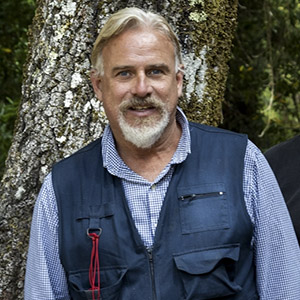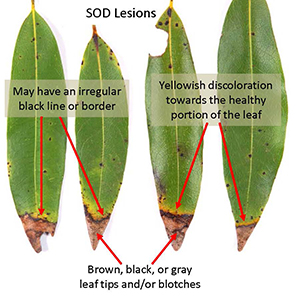Most likely the redwood is experiencing symptoms related to cycles between drought and rainy periods. However, if there is a significant presence of California bay laurels intermixed with redwoods, there may be enough pressure from the SOD pathogen to also cause problems on redwoods, both native and exotic. Any SOD oak infections are likely directly connected to bay laurels, as both oaks and redwoods can become infected by the large number of spores produced on bay laurel leaves. The pathogen does not move from oaks to other trees.
Take the following precautions when using local acorns for oak reforestation projects in areas impacted by SOD to help minimize pathogen spread.
- Place acorns in a 10% dilution of bleach for 10 minutes then rinse twice with tap water.
- Make sure volunteers’ shoes are free of soil, mud, and organic material.
- Be sure tools being used are clean and free of soil, mud, and organic material.
The most important part of ensuring that tools will not spread SOD is to be sure that no organic debris or soil is present on the tools. This applies to all portions of each tool, including parts that may not be visible (like the return of a chain in a chainsaw or the interior of a tree chipper). For more information on cleaning tools and equipment, go to https://nature.berkeley.edu/garbelottowp/?p=1208.
It is always advisable to first have a tree tested before removal to be sure P. ramorum is present. If you are noticing symptoms in spring, attend a nearby SOD Blitz for information on sampling and lab submissions. For more information, go to sodblitz.org.
When treating oak trees with phosphites to help prevent SOD, it may be beneficial to apply the topical treatment to bark that is dry. Rain occurring after the treatment (even immediately after) does not affect the application. If injecting phosphites, it may be better to avoid rainy days, as lower evapotranspiration is often documented for trees in such conditions. Lower evapotranspiration rates may result in poor tree absorption of phosphites.
Note: Topical treatments are most effective when applied in the fall, from November to early December. Injections should only be performed from fall to early winter.
When trying to determine if an oak may have SOD (caused by the plant pathogen Phytophthora ramorum), the first step is to determine if the tree lies within 1 km of a known outbreak. This can be done by accessing SODMAP at www.sodmap.org or by uploading the free “SODMAP Mobile” app to your smartphone. Stand next to the tree in question and tap the risk button. A response of moderate or high risk would suggest Phytophthora ramorum may be present. The next step is to confirm it is indeed P. ramorum. Make sure the oozing is not wetwood, or bacterial flux, which typically is associated with much more oozing and often has an unpleasant odor. Bacterial flux usually has a watery secretion running down the trunk that originates from a wound or branch crotch. If all symptoms align with SOD, the next step is to test for P. ramorum. If a symptomatic California bay laurel tree is within 10 m of the oak, collect symptomatic bay leaves for testing. This is not a definite diagnosis for the oak, but it may be an acceptable one that does not involve wounding the oak tree for sampling. Bay-based diagnosis for an oak may be less accurate after multiple years of drought, as bays may actually turn from SOD positive to SOD negative during extended dry conditions. One can get bay leaves tested by participating in one of the annual SOD blitzes (www.sodblitz.org) or by submitting samples to the California Department of Food and Agriculture. Testing the oak requires debarking a portion of the tree until the margins of the putative SOD lesion under the bark are visible and then plating the margins of the lesion on Phytophthora-selective medium for laboratory analysis.
Survival of P. ramorum (SOD pathogen) in wood chips depends on a few factors:
- Were the chips allowed to become wet?
- What size are the chips?
- Is green waste present?
- What time of year was the wood chipped?
- Where in California are the chips located?
Chips that are piled wet or tarped and include infected green waste (e.g. bay laurel leaves) may support pathogen viability for over 1 year, especially in mild coastal areas. If the wood is chipped in the summer and early fall and the chips are not piled, but rather broadcast in a 1-inch layer in a dry and sun-exposed area, pathogen viability may only be supported for a few weeks, especially if in hotter interior areas.
Survival of P. ramorum (SOD pathogen) in dead hosts or non-plant substrates is extremely variable and strongly affected by climatic factors. Although a comprehensive study on this topic has not conducted, extrapolating from several studies we can say the following:
Soil becomes more infectious from late winter to early summer in the presence of rainfall, so any movement of soil away from a SOD-infested area from January to July could transport viable P. ramorum.
Keep the following in mind:
- The larger the volume of soil moved, the greater the risk.
- In organic rich soils (e.g. top layers of forest soils), pathogen survival is less than 18 months.
- If P. ramorum is present in green waste incorporated in the soil, survival can be much longer (2 years or more).
- In inert soils (e.g. potting mix), the pathogen can survive multiple years. However, for all soils, areas with less temperate climates (cold winters, hot summers) may hasten loss of pathogen viability.
From a practical perspective, if infested forest soil is picked up on tires or shoes from late winter to early summer, the pathogen will likely remain viable for about 1 year, in the absence of incorporated green waste. If soil is picked up from late summer to early fall, survival duration is much less, possibly in the order of a few months.
SOD Blitzes include a training session for blitz volunteers on SOD and proper sampling, followed by time in the field for collecting and marking sample locations. All necessary collection materials are provided to volunteers during the training session for use either the same day of the training or the day after. All samples are to be dropped off at a designated location (location announced at the training session). There are approximately 20 SOD Blitzes in areas of California that have sudden oak death or at risk of disease establishment. Most of the training sessions are offered on Saturday mornings. SOD Blitz schedules for the coming year are posted annually during the last week of January at www.sodblitz.org.
Based on the study published by the UC Berkeley Garbelotto lab in California Agriculture (http://nature.berkeley.edu/garbelotto/downloads/calag2009.pdf), azomite and/or lime washes alone are not effective in controlling SOD.






